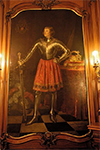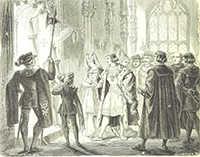Maximilian I: Holy Roman Emperor and Habsburg Superstar
Part 1: Growing into the Role Maximilian I, King of Germany and Holy Roman Emperor, was a giant figure on the European stage, dominating events throughout the Continent for several decades in the 15th and 16th Centuries. His military and political successes set up his Habsburg line well to exert supremacy for many years to come. 
He was born on March 22, 1459, in Wiener Neustadt, Inner Austria. His father was the reigning Holy Roman Emperor, Frederick III (who was also King Frederick IV of Germany), and his mother was Eleanor of Portugal. Frederick's brother Albert raised an army against him in 1462, which included a siege of Vienna that kept the royal family holed up for some time. Albert's death the following year ended the uprising. 
In contrast to his studious, slow-acting father, Maximilian was impulsive and cared far more for fighting and physical activity than for study and learning. Still, Maximilian was Frederick's heir, and so father secured for son a choice bride, Mary of Burgundy, whose father was Charles the Bold, duke of Burgundy (which at the time included Belgium and the Netherlands). The marriage, which took place on Aug. 18, 1477, united two large domains and paved the way for later Austrian success. France also laid a claim to the Duchy of Burgundy, with Louis XI asserting his right to take over from Charles the Bold. Maximilian would have nothing of it and fought against France a handful of times, winning the important Battle of Guinegate in 1479. The conflict continued intermittently for the next few decades. Frederick and Mary had three children, two of whom survived into adulthood: Philip (1478) and Margaret (1480). Mary died in a riding accident in 1482. Maximilian married again, eight years later, to Anne of Brittany. That marriage was conducted by proxy, but the couple never met to marry in person because Pope Innocent VIII invalidated the marriage and Anne married France's King Charles VIII instead. Further complicating matters, Charles had been betrothed to Maximilian's daughter when the girl was just 3; Charles called off the betrothal in 1491 and married Anne of Brittany instead. Maximilian got married a third time, to Bianca Maria Sforza, in 1493. The union brought him dominion over Milan, her homeland, but brought them no children. As Frederick aged, and despite unsuccessful wars in Hungary, he turned to thoughts of succession. As had been done in previous centuries, he had his son, Maximilian, declared co-King of Germany; this occurred in 1486, just as Matthias I Corvinus of Hungary was taking over most of Austria. Maximilian led an army that eventually took it back, four years later. Frederick's health deteriorated sharply in 1493. He died on August 19 of that year, in Linz, after complications from surgery. Maximilian took over fully from his father. Philip had nominally inherited Burgundy from his mother in 1482, but he was only 4 at the time. When Frederick III died, the youth was 15 and Maximilian transferred Burgundian power to him. Next page > European Center Stage > Page 1, 2 |
|
Social Studies for Kids
copyright 2002–2026
David White




